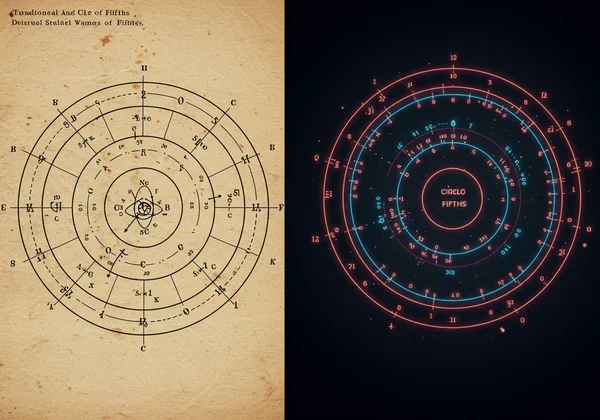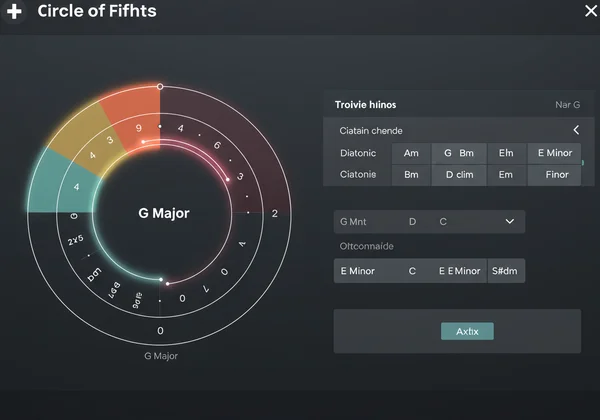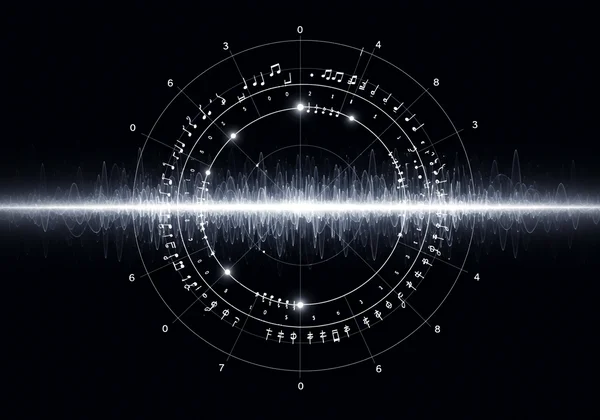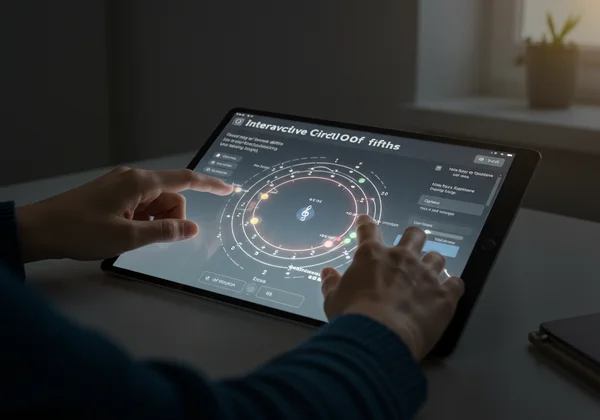Master Circle of Fifths & Music Theory: Solve Common Mistakes with Our Tool
The circle of fifths? It's not just a diagram; it's a superpower for musicians! It unlocks the core secrets behind key signatures, captivating chord progressions, and the very DNA of Western music. Yet, for many students, songwriters, and instrumentalists, it remains a source of frustration. How to use the circle of fifths without feeling overwhelmed? Many musicians grapple with this question, staring at static charts that feel more like abstract diagrams than practical guides.
Ever found yourself tangled up trying to memorize key signatures or craft a chord progression that just sounds... off? You're definitely not alone. The great news is, mastering this concept doesn't have to be a grind. This guide will illuminate the most frequent mistakes musicians make and show you how a modern, interactive approach can transform your confusion into confidence. It’s time to stop just looking at the circle and start using it. With our interactive tool, you can turn theory into practice instantly.
Common Circle of Fifths Mistakes to Avoid
Before you can master the circle, you need to recognize the common pitfalls that trip up so many learners. These errors often stem from trying to learn with outdated, non-interactive methods. Static diagrams in textbooks can't show you the dynamic relationships that make this tool so magical. Let's break down the most common circle of fifths mistakes.

Confusing Key Signatures & Relative Minors
One of the first challenges is simply memorizing what key corresponds to which set of sharps or flats. It's easy to mix up the key of G Major (one sharp) with D Major (two sharps) or get lost when trying to identify the key signatures for minor keys. A related mistake is failing to grasp the relationship between a major key and its relative minor, like C Major and A minor, which share the same key signature.
This confusion leads to practical problems. For an instrumentalist, it means hesitating during a performance. For a composer, it means building a song on a shaky theoretical foundation. The root of the issue is trying to learn through rote memorization alone, without a visual and contextual aid that reinforces these crucial connections. How can you find the relative minor of Eb Major quickly? A static chart requires you to count three steps back, a process that can be slow and prone to error under pressure.
Struggling with Diatonic Chord Identification
Once you know the key, the next step is identifying the chords that naturally belong to it—the diatonic chords. A massive roadblock for aspiring songwriters is not knowing which chords will sound "right" together. What are the chords in G major? Many musicians can name the tonic (G), but struggle to recall the subdominant (C), dominant (D), and the other related diatonic chords (Am, Bm, Em).
This is where many chord progression errors originate. You might throw in a chord that is outside the key without understanding why it sounds dissonant or out of place. Without a clear map, you're essentially guessing. This struggle prevents you from creating smooth, compelling chord progressions and limits your creative palette. The ability to perform quick chord identification is essential for songwriting and improvisation, and relying on memory alone is often inefficient.
Misapplying Chord Progressions & Modulations
The true power of the circle of fifths is revealed when you use it for songwriting and composition. It’s a roadmap for creating powerful chord progressions and seamless modulations (key changes). A common mistake is using progressions that sound cliché or failing to move between keys gracefully. For example, moving from C Major to F# Major can sound jarring if not handled correctly.
Many learners don't realize that adjacent keys on the circle are closely related, making transitions between them sound natural. The ii-V-I progression, a cornerstone of jazz and pop music, is beautifully laid out on the circle, but this relationship is hidden in a static chart. Misunderstanding these harmonic movements is a significant source of requests for circle of fifths help online, as it directly impacts a musician's ability to write and improvise effectively.
How Our Interactive Tool Solves Your Music Theory Problems
What if you could eliminate these mistakes with a single tool? That's precisely why we built this powerful tool. We've transformed the static, confusing diagram into a living, breathing resource that solves your most pressing music theory problems. It's designed to bridge the gap between abstract knowledge and practical application, helping you learn faster and create better music. Explore the circle and see for yourself.
Instant Visualization of Key & Chord Relationships
Forget trying to count sharps and flats in your head. With our tool, you simply click on any key—like G Major—and it instantly highlights everything you need to know. The key signature is displayed, the relative minor (E minor) is clearly shown, and all the diatonic chords are presented in an organized table. This instant visual feedback solidifies the connections in your mind far more effectively than any textbook diagram.

This feature directly solves the problem of confusing key signatures. There’s no ambiguity. You can instantly visualize key signatures and their corresponding chords, turning a frustrating memorization task into a simple act of exploration. It makes understanding concepts like the relationship between a dominant and tonic chord incredibly intuitive.
Auditory Learning: Hear Your Chord Progressions
How many times have you looked at a chord progression on paper and wondered what it actually sounds like? Our tool bridges this critical gap. After you click on a key to see its diatonic chords, you can click on any chord in the table to hear it play. This auditory feedback is a game-changer for solving chord progression errors.

You can now experiment with progressions in real-time. Wondering what a I-V-vi-IV progression sounds like in the key of A Major? Just click on A, then click on the chords in sequence: A, E, F#m, D. This auditory learning connects the theoretical names to the actual sounds, deepening your understanding and helping you develop a better ear. It’s the perfect way to hear the chords and test your songwriting ideas on the fly.
Practice & Personalize: From Learning to Mastery
True mastery comes from practice. Our interactive tool is built for it. Want to test your knowledge of key signatures? Use the "Hide Key Signature" feature to quiz yourself. Click on a key and see if you can name the correct sharps or flats before revealing the answer. This active recall is scientifically proven to be a more effective way to memorize circle of fifths than passive reading.

Furthermore, the tool is customizable for your needs. Whether you read treble, bass, or alto clef, you can switch between them with a single click. For offline study or teaching, you can export the entire diagram as a high-quality PDF. This powerful blend of interactive practice and personalized learning isn't just a clearer path to mastery—it's an exhilarating musical adventure that static resources can only dream of offering.
Master Your Music Theory: Start Exploring Our Interactive Tool
Ready to transform the intimidating circle of fifths from a mystery into your most trusted musical ally? By understanding the common mistakes and leveraging the right tools, you can transform it into your most trusted musical ally. Stop struggling with static charts and start interacting with music theory in a way that makes sense. See the relationships, hear the chords, and practice until it becomes second nature.
Your journey to mastering music theory starts with a single click. Go ahead, try our free tool today and unlock your full creative potential. Explore a key you've always found difficult, build a new chord progression, and hear the difference for yourself.
Frequently Asked Questions About Circle of Fifths
How to use the Circle of Fifths effectively?
To use it effectively, go beyond memorization. Use it to quickly find key signatures, identify the seven diatonic chords within any key, and discover strong chord progressions by moving between adjacent segments of the circle (like the classic ii-V-I). The best way to learn is by doing, which is why an interactive tool like our circle of fifths tool is so powerful. It allows you to click, see, and hear these concepts in action.
What is the Circle of Fifths used for in music?
It's used for several core musical tasks. Composers use it to write chord progressions and modulate between keys. Performers use it to understand the key of a piece and to improvise. Music students use it as a foundational guide to understand the relationship between all 12 tones of the chromatic scale, their corresponding key signatures, and their relative major and minor keys.
How can I memorize the Circle of Fifths quickly?
While mnemonic devices like "Father Charles Goes Down And Ends Battle" can help, the fastest way is through consistent, interactive use. Instead of just staring at a chart, use a tool that forces you to engage. By repeatedly clicking keys and seeing the results on our tool, you build muscle memory. The "Hide Key Signature" feature is an excellent self-testing tool to accelerate this process and truly master music theory.